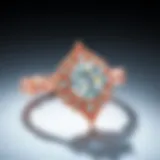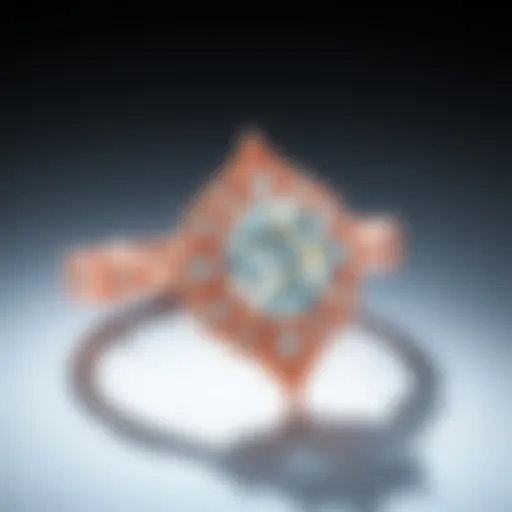Measuring the Refractive Index: Techniques and Implications


Intro
The refractive index is a fundamental property of materials, driving various applications across industries. Understanding how it varies among different materials is not merely academic; it has real-world ramifcations, especially within the realm of gemstones. To effectively measure this index, several techniques have emerged, each with its unique strengths and challenges. This article will delve into those methods, illustrating their importance in evaluating gemstones and their broader implications.
Accurate measurement of refractive index is a cornerstone for gemologists and jewelers, who rely on these values when grading stones and determining their value. But beyond gemstone evaluation, refractive index measurements play pivotal roles in optics and materials science, affecting everything from lens design to fiber optics.
In what follows, we explore various techniques employed in measuring the refractive index, including those that utilize critical angles, interferometry, and refractometry. We will also examine how these measurements can influence our understanding of gemstone quality and value.
Are you ready to embark on this journey through the world of refractive index measurement? Let’s start with an overview of gemstones, their physical attributes, and how these relate to their refractive indices.
Understanding Refractive Index
The refractive index serves as a crucial cornerstone in both scientific and practical realms, influencing a diverse range of materials, particularly in gemology and optical sciences. Understanding the refractive index allows professionals and enthusiasts alike to ascertain how light interacts with different substances, which holds valuable implications for evaluating gemstone quality, crafting effective optical devices, and conducting various scientific analyses.
Definition and Importance
The refractive index, often symbolized as "n", quantitatively describes how much light slows down when it travels through a medium compared to its speed in a vacuum. It is calculated using the formula:
[ n = \fraccv ]
Where:
- n is the refractive index,
- c is the speed of light in a vacuum,
- v is the speed of light in the medium.
This seemingly straightforward number has far-reaching effects. For instance, a typical refractive index for diamond is approximately 2.42, meaning light moves over twice as slowly in diamond compared to its speed in a vacuum. This fundamental understanding impacts various fields. In gemology, the refractive index helps in identifying gemstones, as each type has its unique signature. This information is vital for jewelers and collectors who seek authenticity and quality in their materials.
Moreover, in engineering and optics, knowing the refractive index aids in the design of lenses and optical fibers, contributing to advancements in telecommunications and imaging systems. It helps shape concepts like total internal reflection, making the refractive index a linchpin in various technologies.
Historical Context
The journey to understanding the refractive index is rich with historical significance, tracing back to early experiments with light. The ancient Greeks, particularly philosophers like Euclid and Ptolemy, had rudimentary insights into light behavior but lacked the mathematical frameworks we rely on today.
Fast forward to the 17th century, the pivotal work of Willebrord Snellius or Snell, who mathematically described the laws of refraction, transformed our comprehension of light. His formula, which established the relationship between the angles of incidence and refraction, laid the groundwork for measuring the refractive index effectively.
In subsequent years, advancements continued as scientists like René Descartes and Isaac Newton delved deeper into optics, refining methods to observe and measure light's refractive properties. The invention of the refractometer in the 19th century by Ernst Abbe marked a significant leap, allowing precise and efficient measurement of refractive indices across diverse materials, thus revolutionizing both scientific study and industrial applications.
Today, as techniques evolve, incorporating advanced technologies like digital refractometers and interferometry, our ability to measure and understand refractive indices continues to advance. This ongoing exploration invites gemologists, scientists, and enthusiasts to appreciate the intricate properties of materials that have defined trade and technological innovation for centuries.
Theoretical Framework
Understanding the theoretical framework of refractive index measurement is paramount to grasping the broader implications of the practice, especially within intricate fields like gemology and optics. This framework serves as the backbone for various measurement techniques, allowing researchers and enthusiasts to quantify how light interacts with different materials. The interplay of light characteristics and material properties lays a solid foundation for further exploration into practical applications, thereby showcasing the relevance of these measurements.
Light and Its Behavior
To fully appreciate the concept of refractive index, one must first consider the behavior of light. Light travels in straight lines in a uniform medium and changes its path when entering a different material. This phenomenon lays the groundwork for understanding the essence of refractive index, a key player in how light is transmitted through materials.
When light enters a denser medium, such as glass, it slows down, causing the light to bend towards the normal line—the perpendicular line to the surface at the point of entry. Conversely, when light moves from a denser material to a less dense one, like air, it speeds up and bends away from the normal. This fundamental behavior of light is essential when considering applications such as lens design and gemstone cutting, where precision in light manipulation can mean the difference between ordinary and exceptional.
Light behaves not just as a particle, but also as a wave, manifesting qualities that guide our understanding of many phenomena, from color dispersion to optical illusions. Moreover, varied wavelengths of light travel at different speeds, suggesting that the refractive index can vary with the color of the light, lending credence to the concept that measuring refractive index is more nuanced than it might seem at first glance.
Principles of Refraction
Refraction principles underpin many techniques used to measure the refractive index, shining a light on its complexity. Essentially, refractive index can be defined by Snell's law, which articulates the relationship between angles of incidence and refraction. This law states:
n1 * sin(θ1) = n2 * sin(θ2)
Where:
- n1 is the refractive index of the first medium.
- θ1 is the angle of incidence.
- n2 is the refractive index of the second medium.
- θ2 is the angle of refraction.
The implications of Snell's law extend beyond academic curiosity into practical applications. For instance, understanding these refractive behaviors allows jewelers to craft gemstones that maximize light dispersion across various angles, resulting in a product that sparkles and captivates. This relationship does not merely remain theoretical; it holds significant weight in the selection of materials and design strategies within the jewelry industry, where aesthetic appeal often hinges on effective light manipulation.
Measurement Techniques
Measurement techniques in refractive index determination play a critical role in various scientific and practical applications. Each method comes with its unique approach and suite of advantages and limitations, enhancing the understanding of light behavior in different materials. Knowing which method to use can significantly affect the precision and accuracy of the measurements. This section delves into prominent techniques like the critical angle method, refractometry, and interferometry, each contributing robustly to the field and its applications in gemology and optical sciences.
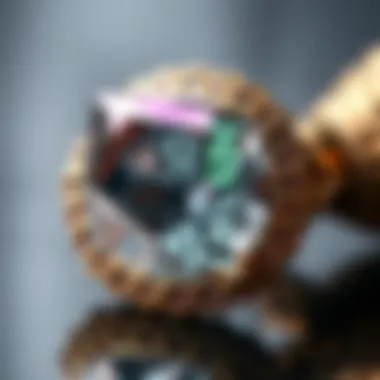

Critical Angle Method
Setup and Procedure
The critical angle method relies on a fundamental principle of light's behavior at the interface between two media. To perform this measurement, a light beam passes from one medium to another – for example, from air into a gemstone. The setup often involves a light source aligned with a transparent sample, where the angle of incidence is varied. The crucial point arises when light does not pass through the interface but instead reflects, demonstrating total internal reflection.
This method is beneficial for its simplicity and requires relatively accessible equipment, often appealing when assessing materials like gemstones. A significant characteristic is the ability to derive refractive indices directly through geometric relationships, rooted in Snell's Law. However, this method is sensitive to experimental conditions, such as surface cleanliness and alignment accuracy, which can impact results.
Advantages and Limitations
The critical angle method has some noteworthy advantages, including its straightforward application and the minimal equipment needed – making it popular among both amateur and professional gemologists. However, it has limitations, particularly when working with opaque or complex materials. The necessity of a clear surface and a homogeneous medium means that certain gemstones can pose challenges, as inclusions or blemishes may hinder accurate readings. Hence, while effective, the method requires careful consideration of the sample's characteristics to ensure reliable results.
Refractometry
Types of Refractometers
Refractometry offers various specialized instruments for measuring the refractive index. These include handheld refractometers, digital and Abbe refractometers, catering to different levels of precision and application scenarios. The handheld refractometer is particularly popular for gemological purposes, allowing collectors to assess gemstones quickly.
Each type has specific characteristics tailored to specific needs. For example, Abbe refractometers are known for their high accuracy and are often used in laboratory settings. On the flip side, handheld versions offer portability, enabling on-the-spot evaluations in the field.
Calibration Techniques
Calibration techniques are paramount in ensuring that refractometers yield precise readings. This process involves comparing the instrument's readings against a standard or known refractive index substance. For instance, using pure water or a glycerin solution, gemologists can establish a baseline for accuracy. Regular calibration is suggested to counteract drift in readings due to wear, temperature changes, or environmental factors.
The unique aspect of calibration techniques is the precision they add to refractive index measurements, increasing reliability in gem valuation. However, recalibrating can be a time-consuming process, requiring careful handling and a systematic approach to maintain the integrity of results.
Interferometry
Basic Principles
Interferometry hinges on the principle of superimposing light waves to observe phenomena such as phase shifts and interference patterns. When light passes through a sample, it divides into two separate beams. As these beams traverse different paths and later converge, the resulting interference pattern serves as a direct measurement of the sample's refractive index.
This technique allows for incredibly high precision and is often appreciated in advanced scientific and industrial applications. Its ability to quantify tiny changes in the refractive index makes it especially useful in research contexts where precision is paramount. However, the complexity of the apparatus means that a steep learning curve often accompanies its use.
Application in Refractive Index Measurement
Application in refractive index measurement through interferometry is not only about gauging the refractive index; it often unveils additional material properties. This method can also provide insights into thickness and uniformity, which are essential for optical components.
Interferometry stands out because it is non-destructive, meaning that samples can often be recovered after measurements – granting versatility across various domains. However, the costs associated with acquiring equipment and training can be high, and any environmental disturbances can lead to inaccuracies in readings.
"Interferometry not only measures refractive index; it opens a window into the structural integrity and quality of materials, making it invaluable in both gemology and broader optical applications."
Experimental Procedures
Experimental procedures are at the heart of accurately measuring the refractive index of materials. They set the stage for the precise evaluation of light behavior as it interacts with different substances. The importance of this section lies in guiding the reader through the methodologies that affect the quality and reliability of refractive index measurements. Understanding the correct procedures can not only yield better results but also ensure consistency and repeatability critical in both scientific research and practical applications.
Sample Preparation
In any realm of experimental science, the mantra often echoes: "Garbage in, garbage out." This holds especially true when it comes to sample preparation in refractive index measurements. Just as a chef’s ingredients dictate the quality of the dish, the quality of the sample affects the accuracy of the refractive index obtained.
When preparing samples, several key factors must be taken into account:
- Purity of the Material: Impurities can skew results. For instance, a gemstone with inclusions may reflect light differently than a pure specimen. To avoid this, ensure that the sample is as clean and pure as possible.
- Surface Smoothness: Any rough or uneven surfaces can cause scattering or distortion of light. This is akin to looking through a dirty window; clarity is lost. Polishing surfaces is often necessary for accurate readings.
- Consistent Thickness: Variability in thickness can affect the angle of refraction. Thin and uniformly cut samples generally yield more reliable data than thick or uneven specimens. A simple visual inspection may help, but instruments can provide higher precision.
- Environmental Conditions: Temperature and humidity can alter the refractive properties of materials. Therefore, control these factors during experiments to maintain consistency. A stable lab environment helps in eliminating these variables.
By focusing on these aspects of sample preparation, a solid foundation is laid for the experiments that follow, ensuring that the results reflect true optical properties, leading to better interpretations and applications.
Safety Considerations
Safety is not just a side note in experimental procedures; it’s paramount. Each step taken during the measurement process carries inherent risks, especially when using chemicals or sophisticated instruments. Thus, adopting a comprehensive safety protocol cannot be overstated.
Here are key safety measures:
- Personal Protective Equipment (PPE): Wearing goggles, gloves, and lab coats may feel cumbersome, but they protect against chemical exposure or glass breakage. When dealing with organic solvents or other hazardous materials, these precautions are critical.
- Proper Handling of Equipment: Many refractive index measurement tools, such as refractometers, are delicate and can break easily. Employ proper techniques for handling to avoid accidents.
- Understanding Chemical Hazards: If utilizing chemicals for sample preparation, it’s crucial to be familiar with their Material Safety Data Sheets (MSDS). These documents provide detailed pathways to handle, store, and dispose of materials safely.
- Emergency Protocols: Having clear emergency procedures in place is vital. Know the location of fire extinguishers, eyewash stations, and first-aid kits. Additionally, understanding how to react in case of spills or accidents can prevent panic and misinformation down the line.
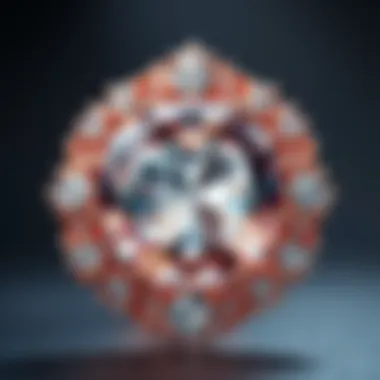

By implementing these safety considerations, one can ensure a secure environment where accurate refractive index measurements can be pursued without undue risks. Through rigorous preparation and a commitment to safety, researchers and hobbyists can engage in the insightful world of optical science and gemstone evaluation with confidence.
Applications in Gemology
The study of refractive index plays a critical role in gemology, serving as a cornerstone for the assessment and evaluation of gemstones. Understanding how light interacts with various materials not only aids in determining their fundamental characteristics but also enhances the artistry involved in gemstone jewelry design. Every gemstone exhibits unique light properties that are tied intricately to its refractive index, which creates a fascinating interplay between science and art. Let's delve deeper into its applications, its significance, and the benefits it brings to gem enthusiasts and professionals alike.
Quality Evaluation of Gemstones
When it comes to assessing the quality of gemstones, the refractive index serves as a vital indicator of authenticity and desirability. Each gemstone possesses a specific refractive index range that can be used for identification and grading purposes. For instance, diamonds have a refractive index of around 2.42, indicating their exceptional brilliance. Conversely, quartz has a much lower refractive index, usually about 1.54 to 1.55. These differences can guide gemologists in distinguishing between a genuine stone and an imitation.
Moreover, a higher refractive index often correlates with better brilliance and fire, factors that might sway the decision of a potential buyer. By accurately measuring the refractive index, gemologists can provide insights into the overall quality of the stone, including its clarity and cut.
"The refractive index is not just a number; it's a key that unlocks the beauty of gemstones."
Identifying Gemstone Varieties
Beyond quality evaluation, measuring the refractive index is instrumental in identifying various gemstone varieties. The world of gemstones is vast and teeming with similar-looking stones that can easily confuse even seasoned collectors. For example, distinguishing between a tourmaline and an emerald may seem daunting. However, with precise refractive index measurements, this task becomes significantly more manageable.
Different gemstones have distinct refractive indices, and utilizing this knowledge allows gemologists to make conclusive identifications. The refractive index of a gemstone, coupled with other identifying characteristics such as color and inclusions, creates a clearer picture of each stone’s identity. This knowledge is essential not only for gem dealers and designers but also for collectors who wish to ensure their pieces have accurate provenance.
In summary, the applications of refractive index measurement in gemology provide both practical and aesthetic advantages, empowering professionals and enthusiasts alike to appreciate and verify the splendor of gemstones with greater confidence.
Factors Affecting Refractive Index
In the realm of optics, the refractive index serves as a cornerstone for understanding how light interacts with various materials, including precious gemstones. This section probes the factors influencing the refractive index, providing foundational insight that is crucial for gemstone enthusiasts, collectors, and all who engage in the jewelry domain. Understanding these elements not only enhances one's appreciation of gemstones but also informs purchasing decisions and design choices.
Temperature Variability
The refractive index does not remain a steadfast figure; rather, it fluctuates with changes in temperature. For crystalline materials, even minor shifts in heat can alter molecular interactions and spacing, thus influencing how light bends as it passes through. Generally, as temperature rises, the refractive index tends to decrease for most materials. This relationship can be illustrated through the equation:
n = C / (T + K)
where n is the refractive index, C is a constant, T is the temperature, and K is another constant.
For gemstone testing, accurately measuring the refractive index at a controlled temperature is imperative. Variations due to heat can lead to misinterpretation of a gem's quality or even its authenticity. Consequently, it's wise for gemologists to always note the conditions under which their measurements are taken to prevent confusion later on.
Chemical Composition
The chemical makeup of a material shapes its optical properties profoundly. For instance, silicon dioxide has a refractive index around 1.54, while gallium phosphide reaches approximately 3.52. This variance shows that the specific elements and their arrangements in the crystal lattice determine how densely the material interacts with light. For jewelers and gemologists, knowing the chemical composition is vital. It allows for the identification of materials, potentially distinguishing a diamond from a moissanite, for example— both having similar appearances yet different refractive properties.
Chemical impurities, too, can impact a stone’s refractive index. In colored gemstones, trace elements such as chromium in emeralds or iron in sapphires can either enhance or diminish the stone's optical features. The role of composition cannot be understated, as it directly correlates to the clarity and brilliance of gemstones.
Physical Structure
Physical structure refers to the arrangement and organization of atoms within a material. Crystalline structures, whether they be cubic, hexagonal, or another form, dictate how light travels through them. Variations in gemstone structure result in differing refractive indices. For instance, the cubic structure of diamonds refracts light remarkably well, granting them their signature sparkle, while the tetragonal structure of zircon yields a different optical behavior.
Physical flaws and inclusions further complicate this picture. Bubbles trapped within a stone or a crack can scatter light inconsistently, resulting in anomalies in perceived refractive value. Therefore, any thorough gemstone evaluation must consider both macro and microforms of physical structure to capture a holistic understanding of a stone's optical properties.
The refractive index is like a gemstone's fingerprint; it reveals the hidden tales of its chemical and physical origins.
Each of these factors—temperature, chemical composition, and physical structure—plays a crucial role in determining the refractive index, and consequently, the optical word of gemstones. Knowledge in these areas will enhance one's ability to assess the quality and authenticity of stones, making for more informed choices in acquisition and design.
Limitations of Current Methods
In the realm of measuring the refractive index, understanding the limitations of current techniques is paramount. Each method, while valuable in its own right, comes with unique challenges that can influence the accuracy of results. For gemstone enthusiasts, collectors, and designers, recognizing these limitations can translate into better decision-making when it comes to assessing gemstone quality and value.
Measurement Errors
Measurement errors can stem from various sources, including environmental factors and user capabilities. For instance, even slight temperature fluctuations can lead to discrepancies in readings. This is particularly critical when measuring materials that are sensitive to heat, as the refractive index can shift in response to temperature changes. On top of that, the alignment of the equipment plays a crucial role in achieving precise measurements. A minor misalignment could skew the results, leading to potentially misleading conclusions.
Some common sources of error include:
- Calibration issues: Instruments may not be calibrated correctly, leading to consistent inaccuracies.
- Operator skill: The experience level of the user can significantly affect the outcomes.
- Sample purity: Impurities within the material can distort the light path and ultimately influence measurements.
The takeaway is clear: it's essential for users to pay close attention to these variables to improve the reliability of their measurements. By being aware of the potential for measurement errors, practitioners can take the necessary precautions to mitigate them, thereby ensuring more accurate readings.
Instrument Precision
Instrument precision is another critical factor that plays a significant role in the accuracy of refractive index measurements. Different techniques and instruments operate within varied limits of precision. For instance, while digital refractometers might offer high precision, they also come with the caveat of being sensitive to fluctuations in environmental conditions.
Moreover, the choice between different types of refractometers, such as handheld or more sophisticated lab-grade devices, can yield varying results. Handheld models may be convenient for fieldwork but often lack the precision required for fine measurements that gemstone professionals demand.
When evaluating a gem’s refractive index, one must consider both the precision of the measuring instrument and the application context.
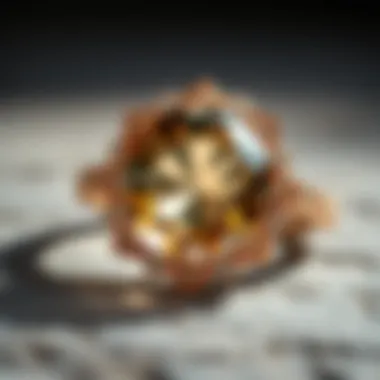

"A high level of precision in measurement is not merely a technical requirement but a fundamental need for accurate gemstone valuation."
In practice, using the right instrument tailored for specific tasks can elevate the quality of measurements significantly. Ensuring regular maintenance and calibration of equipment is equally important to preserve its precision over time.
Recent Advances in Measurement Technology
In the rapidly evolving field of optics, the methods for measuring the refractive index have taken remarkable strides recently. These advances are not merely technical upgrades; they represent a significant leap in our ability to analyze and understand materials with precision. For gemstone enthusiasts, collectors, and jewelry designers, knowing these developments can enhance their expertise and help them make better-informed choices in both professional applications and personal collections.
Emerging Technologies
Recent advancements in measurement technology have introduced several innovative techniques. Optical coherence tomography (OCT), for instance, has gained a foothold in various industries due to its ability to provide high-resolution, cross-sectional images of internal structures without invasive procedures. This technique can significantly impact gemstone analysis, allowing professionals to assess internal characteristics and refractive properties with unprecedented clarity.
Another noteworthy technology is the development of laser-based systems, which promise enhanced accuracy when determining refractive indices. These systems capitalize on the unique properties of laser light, minimizing errors associated with traditional methods. Using lasers can lead to efficient measurements, reducing the time from hours to mere minutes without sacrificing precision.
Additionally, advancements in computational techniques, such as machine learning algorithms, have started to emerge in refractive index measurement. By training algorithms on vast datasets, it is possible to predict refractive indices based on various parameters, providing an automated solution that can save considerable time and effort in laboratory settings.
- Benefits of Emerging Technologies:
- Enhanced measurement precision
- Reduced analysis time
- Non-invasive assessment options
- Machine learning integration for predictive analysis
Comparative Studies
Comparative studies play a critical role in understanding how these new technologies stack against traditional measurement methods. By examining key parameters like accuracy, speed, and practicality, gemstone professionals can discern the ideal measurement techniques for their specific needs.
For instance, studies comparing laser-based systems with traditional refractometers indicate a marked improvement in data accuracy with lasers, especially in samples with complex internal structures. Furthermore, comparative analyses have revealed that OCT technology might provide superior results when it comes to evaluating inclusions and other imperfections within gemstones. These insights are crucial for gemologists aiming to ensure the highest quality in their evaluations.
- Main aspects of comparative studies include:
- Accuracy assessments
- Speed of measurement processes
- User-friendliness of technologies
- Cost-effectiveness considerations
"The pace of innovation in refractive index measurement technology is both a challenge and an opportunity for gemstone professionals seeking to stay ahead in a competitive market."
As new technologies continue to emerge, the implications of these advancements for measuring the refractive index cannot be overstated. They pave the way for more efficient and precise evaluations, significantly aiding in the quality assessment of gemstones and influencing decisions in the jewelry industry. By keeping an eye on these developments, gemstone enthusiasts can harness cutting-edge techniques in their endeavors.
Future Directions
The exploration of refractive index measurement is ever-evolving, particularly as it intersects with advancements in technology and science. Understanding these future directions not only guides existing research but also lays down pathways for innovative applications in gemstone analysis and beyond. This section discusses key elements in the future outlook, focusing on emerging methodologies, technological integration, and broader implications for various fields.
Innovative Approach
As we look ahead, new strategies in measuring refractive index are developing, fueled by the blending of fields such as optoelectronics and materials science. A key innovative approach is the use of nanotechnology. By manipulating materials on a nano-scale, researchers can create devices that measure refractive index with unparalleled precision. For instance, employing nanostructured surfaces may lead to enhanced sensitivity when evaluating gemstones, allowing gemologists to discern subtle differences in refractive properties that traditional techniques might overlook.
"The future beckons fresh techniques in refractive index measurement, ensuring even more accurate evaluations in gemology and material science."
Moreover, the integration of machine learning algorithms promises to revolutionize data analysis in refractive index studies. These algorithms can sift through vast amounts of measurement data, identifying patterns that human analysts might miss. This could lead to the creation of predictive models, significantly enhancing the efficiency of gemstone quality assessment.
Interdisciplinary Insights
Future advancements in refractive index measurements will not solely emerge from optical physics but will benefit from insights across various disciplines. Collaboration among chemists, physicists, and material engineers can yield breakthroughs. For example, an interdisciplinary approach could involve developing new transparent materials with tailored refractive indices by controlling their chemical compositions and molecular structures. Such innovations are critical in fields like photonics, where precise control of light is necessary.
Additionally, involving data science experts in the study of refractive indexes could lead to a better understanding of how environmental factors—like temperature and pressure—affect measurements. This higher degree of knowledge can enhance the reliability of refractive index data in industrial applications, from manufacturing to quality control in gem markets.
For further readings on this subject, you can refer to resources like Britannica, Wikipedia, and relevant discussions on Reddit.
Each step forward in these directions will likely uncover new understandings and applications that can modify our approach to measuring refractive index in ways we have yet to imagine.
Culmination
The study of refractive index holds substantial importance in a variety of fields, particularly in gemology and optical technologies. This article illuminated the various techniques for measuring refractive index, highlighting their intricate relationship with gemstone quality and their broader implications in scientific research.
Summary of Key Points
In reviewing the previous sections, we can distill a few vital points:
- Understanding the Refractive Index: We defined the refractive index and discussed its critical role in understanding how light interacts with different materials. This parameter is pivotal for professionals in both gemology and optics, impacting the overall assessment of gemstones and their applications in optical devices.
- Measurement Techniques: Several measuring techniques were explored, including critical angle measurement, refractometry, and interferometry. Each method offers unique advantages and limitations, which affect the precision and applicability of the results.
- Experimental Procedures and Safety: Proper preparation and adherence to safety considerations are essential in obtaining accurate results. This emphasizes the meticulous nature of working with optical materials and samples.
- Applications and Implications: Gleaned insights into how variations in refractive indices can inform gem quality evaluation and how this translates into market value and consumer trust in gemstones.
- Emerging Technologies and Future Directions: Recent advancements are paving the way for more precise measurements and interdisciplinary applications, hinting at exciting possibilities for further research and collaboration.
The refractive index forms the bedrock of optical understanding, marrying science with tangible impact in the gemstone and optics industries.
For further reading on refractive index and its implications, consider exploring resources such as Wikipedia or the Encyclopedia Britannica.




